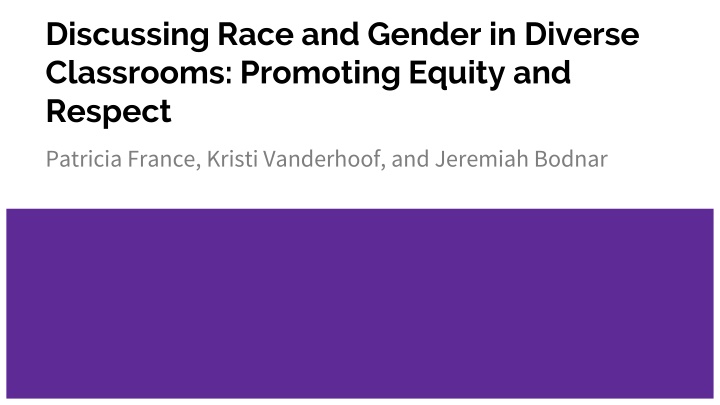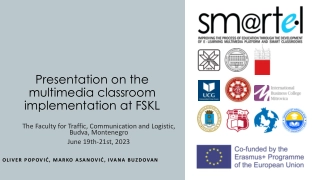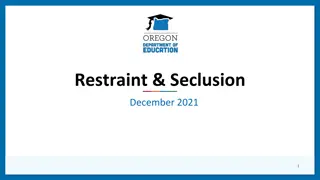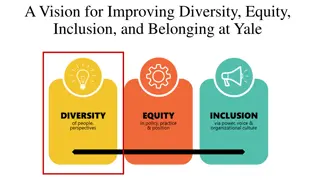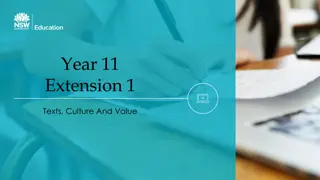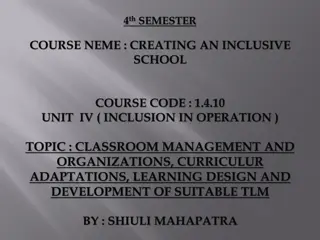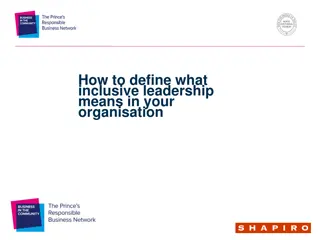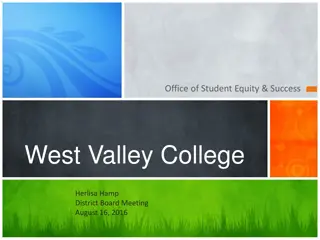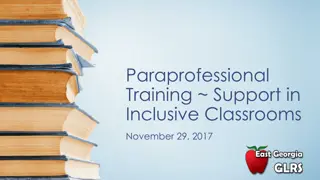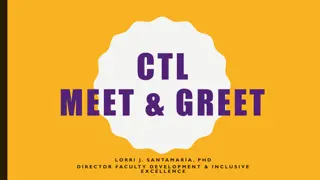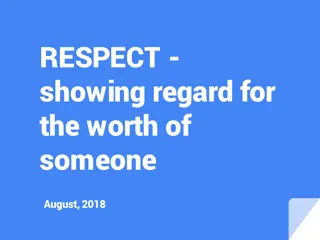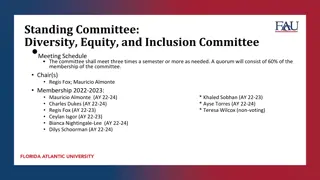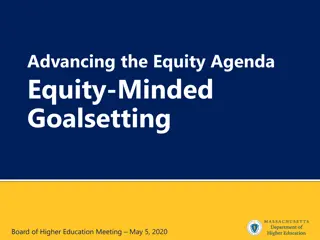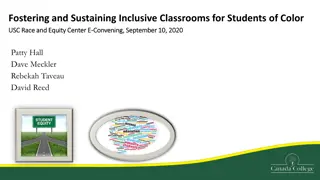Fostering Equity and Respect in Diverse Classrooms Through Inclusive Texts and Discussions
Explore strategies for promoting ethical behavior, tolerance, and mutual respect in diverse classrooms by selecting inclusive texts and engaging students in critical discussions. Emphasizing the importance of challenging stereotypes and empowering students to become agents of change and social justice. Navigate challenges of discussing race and gender while highlighting the achievements of men of color in various fields.
Download Presentation

Please find below an Image/Link to download the presentation.
The content on the website is provided AS IS for your information and personal use only. It may not be sold, licensed, or shared on other websites without obtaining consent from the author.If you encounter any issues during the download, it is possible that the publisher has removed the file from their server.
You are allowed to download the files provided on this website for personal or commercial use, subject to the condition that they are used lawfully. All files are the property of their respective owners.
The content on the website is provided AS IS for your information and personal use only. It may not be sold, licensed, or shared on other websites without obtaining consent from the author.
E N D
Presentation Transcript
Discussing Race and Gender in Diverse Classrooms: Promoting Equity and Respect Patricia France, Kristi Vanderhoof, and Jeremiah Bodnar
Las Positas Colleges Values Statement Las Positas College thrives as a collaborative teaching and learning community committed to integrity and excellence by: 4. Promoting ethical behavior, tolerance and mutual respect in a diverse community 6. Holding firm to the belief that each of us makes an astonishing difference.
A note about choosing texts that reflect diversity and address student equity gap From Teaching Men of Color in the Community College: A Guidebook (Wood, Harris, & White, 2015): Choose texts that show the vital roles that people of color play in society Don t limit texts to slavery and the Civil Rights Movement of the 1960 s Give current examples of men of color who have achieved success in STEM and business (achievements underrepresented in the media) Discuss how men of color might be positively or negatively affected by current situations (legal and political) in our society
But how do we discuss these texts in a way that promotes ethical behavior, tolerance and mutual respect in a diverse community ? According to Hackman (2005), content alone is insufficient to create democratic, empowering classroom settings, or to adequately prepare students to become active agents of change and social justice in their lives and communities. Discussion is important because presentation of information as truthdevoid of critique runs the risk of creating a dogmatic and prescriptive classroom environment.
Challenges of Discussing Race in the Classroom Kristi s experience with discussing The Myth of the Latin Woman by Judith Ortiz Cofer Focus of the unit: Racial stereotyping Cofer s article is about different stereotypes about Latinas that she has confronted in her life. In one of the key scenes, she talks about the stereotype that Latinas are uneducated and work in domestic jobs.
Quote from the passage The media-engendered image of the Latina in the United States has been documented by feminists, who claim that such portrayals are partially responsible for the denial of opportunities for upward mobility among Latinas in professions....One such incident that has stayed with me, though I recognize it as a minor offense, happened on the day of my first public poetry reading. It took place in Miami in a boat-restaurant where we were having lunch before the event. I was nervous and excited as I walked in with my notebook in my hand. An older woman motioned me to her table. Thinking (foolish me) that she wanted me to autograph a copy of by brand-new slender volume of verse, I went over. She ordered a cup of coffee from me, assuming that I was the waitress. Easy enough to mistake my poems for menus, I suppose. I know that it wasn t an intentional act of cruelty (Cofer, p. 49-50)
Students reactions to this and how Ive handled them Some Caucasian students reactions: I don t think this kind of stuff happens anymore. I don t think she mistook her for a waitress because she s Latina. I think she s overreacting. How do you think Latinas in the classroom felt when they heard these comments? First time this happened: My colleagues in Mexico said this happened to them often when they were studying or teaching in the US, but not in Canada Second time: What do you think? Do these things still happen? Third time: Would any of the Latinas in the classroom like to share their
Pattys experience with discussing Class in America by Gregory Mantsios Focus of the essay: refers to race, different ethnic groups, and geographic locations and how Americans don t discuss economic class. In "Class in America" by Gregory Mantsios, the workings of economical classes in America are discussed. People in America don't talk about class because they refrain from classifying each other through classes.
Quote from Mantsios essay Regardless of their class standing women and members of minority races are constantly dealing with institutional forces that are holding them down precisely because of their gender, the color of their skin or both (194). In other words, being female and being nonwhite are attributes in our society that increase in chances of poverty of lower class standing (195).
Students reactions to this and how Ive handled them Some students deny that only certain groups are affected by poverty. We ALL face poverty and its up to you to be successful Reading Responses:the summary of the essay focuses on how Caucasians are not affected. Student didn t really elaborate beyond race and responses were more defensive.
Jeremiah Bodnar Wait? Why is he talking about this? Feminist Philosophy and African American Lit. Hitting the issue straight on - metacognition
Modern and Contemporary Theory Hegel on Self and Other (5 min) Alcoff on Speaking for Others (5 min)
Self and Other in Hegel's Phenomenology of Mind (1807, Section B, IV) 1. Identity is found in relation to others 2. We must see ourselves reflected by others 3. We battle to make others reflect our view back to us 4. One consciousness wins 5. The winner imposes his view of himself (and the other) on the other 6... 7...
Self and Other in Hegel's Phenomenology of Mind (1807, Section B, IV) 1...5 6. Conclusion 1: The oppressor can avoid seeing the flaw because of his position 7. Conclusion 2: Who we are affects what we understand Hegel's long term view: Eventually we will learn and overcome oppression
The Problem of Speaking for Others, Linda Alcoff (1991) Three examples of problematic speaking for others: 1. Anne Cameron at a book fair 2. Bush (1989) speaks for Panamanians 3. A white male says he can't speak about women and race
The basic problem of speaking for others: When those of us in power speak for (or about) those with less power, how do we avoid imposing our view and disempowering them?
Alcoff says we must avoid these two opposing stances: 1. Avoid saying we can speak for others because if we are truly objective these issues don't apply. * Objective truth may exist * But power affects all discourse
Alcoff says we must avoid these two opposing stances: 2. We should avoid saying, "We should never speak for others." * It abnegates responsibility * It can be willful ignorance * Sometimes "outsiders" help * Refusing to speak is still speaking * Group membership is complex and changing
Alcoffs conclusions: 1. Question the impetus to speak 2. Be aware of power relations 3. Be responsible and accountable 4. Think about the effects in each context
Mistakes I have made Dangerous humor Lecturing on and on to avoid hard conversations Most white men (Instead societal expectations) Don t focus on your fear. (Focus on protecting them)
Small groups Get into small groups of 3-4 people Suggested norms for our discussion: Don t interrupt. Let the person finish telling their story before you ask questions. Ask and answer questions in a respectful way. Remember that we don t have all the answers. Assume that we all want what s best for our students. Our goal is to learn from each other. Are there any norms you would like to add or modify?
In small groups, share some of your experiences 1. Which texts about race have you discussed in your classes? 2. What kinds of challenges did you face when moderating a discussion about those texts? 3. Which topics did students bring up, and how did you address them?
Share with the group What are the similarities, if any, in the types of challenges you faced? What did you learn from your colleagues?
Recommended Ways to Prepare for Difficult Discussions 1. Build rapport and a safe community first Do ice-breakers and group work at the beginning of the semester. Say hi to students when you see them in the halls and take an interest in their lives and goals. Tell students that their opinion matters, but they must support it with evidence. Avoid discussion and instead assign reflective responses if classroom dynamics are oppositional (Washington & Humphries, 2011).
2. Set norms Be explicit about topics that are off limits (Washington & Humphries, 2011) For example, Humphries tells her history students that blatantly unconstitutional comments (e.g. slavery wasn t so bad) are off limits If it is not something you would hear being debated on the news, it is off limits If you think you might deeply offend someone, don t say it Tell students they have a right to have viewpoints that are off limits, but they may not share them since they would detract from the positive learning environment
2. Set Norms (contd.) Have students set their own norms (reasonable ones) and then type them up and post them or give them as a handout Have students discuss the difference between a debate and an argument, or have them define respectful and disrespectful discourse and then set norms together
Norms that Kristis transfer-level critical thinking class negotiated for discussing a reading about the Holocaust: 1. Don't defend or glorify ideas that has history has decided like Nazism and slavery. 2. Speak with compassion. 3. Everyone has the right to their own opinion. Try not to take things personally. 4. If you are feeling really unsafe, you can wait outside, but you must email Ms. V afterwards and explain why you left. 5. It's okay to present your opinion as long as you provide evidence to support your view. 6. Don't be afraid to take on another's perspective or play devil's advocate.
3. Prepare students by giving an assignment before the discussion Have students answer comprehension questions after reading and then review these as a class. Also, require students to use evidence from the reading and not rely on anecdotal evidence in their discussion. Humphries found that her students discussed the text more maturely and respectfully and students of all races felt more comfortable participating when she set up the discussion in this way (p. 107). Sample questions from Humphries class, after students read about a 2007 court case: What two states were involved in the case? What were the policies being challenged? According to the reading, what was the reasoning behind the policies? According to the reading, why were the policies being challenged?
4. Visualize your reactions to worst-case scenarios The day before, anticipate the types of reactions that your students from all backgrounds might have to the text Visualize how you would respond to those reactions You could picture the discussion in your head or write a journal entry This will help you stay calm if a situation arises
Humphries experience with visualization The day before a discussion on Brown v. Board of Education, Humphries anticipated that one of the students in her classroom would say something about how there is not a problem with racial segregation. The next day, a student commented, I mean, if the schools are really equal, what s the problem? I bet they would rather go to their own school anyways. Humphries responded by asking the class: Do you believe racially segregated schools can be equal? Students said no and could support their response with information from the text about the court case. She followed up with the question: Would racially segregated schools be desirable if --hypothetically speaking--they were equal? Students said no because they believed they could learn more from a diverse population.
Recommended Ways to Prepare for Difficult Discussions 1. Build rapport and a safe community first 2. Set norms 3. Prepare students by giving an assignment in advance 4. Visualize your reactions to worst-case scenarios
Techniques to Help Moderate Discussions Stephen Burton & Susan Furr ( June 2014) Conflict in Multicultural Classes: Approaches to Resolving Difficult Dialogues 1. De-Escalation Only/Supportive Confronting Instructor summarizes of all perspectives of students involved in the discussion. The instructor can use the technique of normalizing the emotional reactions by the students. It is okay to be emotionally confused by the topic . Create in-class reflective writing assignments that allow students to voice their opinions regarding difficult dialogue and issues in the less intimidating space of smaller groups of classmates.
2. Protective Confronting Shut down dialogue and stop intentionally, unintentionally harmful speech or behavior and let it be known that it is unacceptable. As the leader in the classroom it is important to protect the lone outlier by taking steps necessary to protect a student from being mobbed by other students. Also, be aware that it is okay to have a time-out during a difficult discussion. If there is a challenging situation that requires more attention, ask to meet privately with a student to create a protected space to discuss hard conversations. In some cases, you may want to ask to meet with the student one-on-one (possibly with another professor, department chair or dean present) to resolve a conflict or issue outside of class.
Thoughts on the Instructor Disclosing Their Own Personal Views: Reasons that some teachers don t want to disclose: Fear of retaliation or grievance from students and/or administration Concerns about stifling student discussion
Reasons That Some Teachers Disclose Reasons that some teachers disclose: Humphries discloses her views because She feels that it s difficult to be completely neutral or objective She feels that stating her views directly helps her students distinguish between fact and opinion Humphries encouraged her students to disagree with her respectfully, however
Other ground rules: Don t single students out or expect students to represent the perspective of all members of their ethnic group because... Some students may belong to multiple ethnic groups Asking students from marginalized groups to inform the dominant group is wrong. It puts the burden on the minority student to be a spokesperson for their racial groups.
Jeremiahs Recommendations Start with a question that addresses the difficulty ...or with a question that everyone can appreciate and feel good about. Show your confidence in the goodness of your students There are many ways to be a feminist, not just my way Sexual violence and deep hatred may have affected those here Model humane discourse so that students know how to talk
Role-play: Obamas speech after the verdict on Trayvon Martin in 2013 (watch minutes 01:00-06:20) https://www.youtube.com/watch?v=MHBdZWbncXI President Obama Speaks on Trayvon Martin President Obama makes a statement about Trayvon Martin and the verdict of the court trial that followed the Florida teenager's death. As you watch the video, prepare for a discussion about how Obama presents his argument. What evidence does he use? How effective is his argument overall? There are 7 roles total. Watch the video and think about how your role will react. In your discussion, you may use our norms that are on the board.
Debrief on the Role-Play 1. How did it feel being in your role? 2. What insights did you gain? 3. Teacher: what were some of the challenges you faced, and how did you handle them? Would you handle them the same way if you were moderating the discussion again?
Do Reflective Journaling: Humphries engaged in reflective journaling when thinking of ways to address issues that arose in her classroom during discussions of race (Washington & Humphries, 2011) Milner suggest teachers do reflective journaling on their own race and how that influences their teaching and interactions with students (Milner, 2003). See handout for list of Reflective Journaling Questions Choose one of these questions and free-write on it for 5 minutes. Then share with a partner.
Review 1. Build rapport and a safe community first 2. Set norms 3. Prepare students by giving an assignment in advance 4. Visualize your reactions to worst-case scenarios 5. De-escalate, supportively confront, or protectively confront discriminatory behavior, depending on the situation 6. Decide if you want to disclose your views 7. Avoid expecting students to represent their group 8. Participate in reflective journaling
References Alcoff, L. M. (1991). The Problem of Speaking for Others. Cultural Critique, Winter, 1991-92, 5-32. Burton, S., & Furr, S. (June 01, 2014). Conflict in multicultural classes: Approaches to resolving difficult dialogues. Counselor Education and Supervision, 53, 2, 97-110. Hackman, H. W. (2005). Five essential components for social justice education. Equity & Excellence In Education, 38(2), 103-109. Hegel, G. F. W (1967). The Phenomonology of Spirit (G. Lichteim, Trans.). New york, NY: Harper Torch. Cofer, J. O. (2010). The myth of the Latin woman: I just met a girl named Maria. In Las Positas College English Department (Ed.), Mind readings: Short essays for reading, reasoning, and writing. (pp. 45-51). Boston, MA: Bedford/St. Martin's. (Original work published 1993) Mantsios, G. (2013). Class in America--2009. In G. Colombo, R. Cullen, & B. Lisle (Eds.), Rereading America: Cultural contexts for critical thinking and writing (9th ed., pp. 281-299). Boston, MA: Bedford St. Martin's. Milner, H. R. (September 06, 2003). Teacher reflection and race in cultural contexts: History, meanings, and methods in teaching. Theory into Practice, 42, 3, 173-80.
References (continued) Washington, E. Y., & Humphries, E. K. (2011). A social studies teacher's sense making of controversial issues discussions of race in a predominantly white, rural high school classroom. Theory And Research In Social Education, 39(1), 92-114. Wood, J. L., Harris, F., III, & White, K. (2015). Teaching men of color in the community college: A guidebook. San Diego, CA: Montezuma Publishing.
